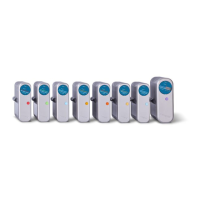MICROPROCESSOR-BASED/DDC FUNDAMENTALS
138
ENGINEERING MANUAL OF AUTOMATIC CONTROL
The use of preprogrammed operators saves time when writing
control sequences and makes understanding of the control
sequence the equivalent of reading a pneumatic control diagram.
Programming schemes often allow program operators to be
selected, positioned, and connected graphically. The alternative
to using preprogrammed operators is to write an equivalent
control program using the programming language furnished
for the controller.
ENERGY MANAGEMENT SOFTWARE
Microprocessor-based controllers can combine control and
energy management functions in the controller to allow sensor
and data file sharing and program coordination. Energy
management functions can be developed via the above DDC
operators, math functions, and time clock values, or they can
be separate program subroutines.
A summary of energy management programs possible for
integration into microprocessor-based controllers follows:
Optimum Start
Based on measurements of indoor and outdoor temperatures
and a historical multiplier adjusted by startup data from the
previous day, the optimum start program (Fig. 5) calculates a
lead time to turn on heating or cooling equipment at the
optimum time to bring temperatures to proper level at the time
of occupancy. To achieve these results the constant volume AHU
optimum start program delays AHU start as long as possible,
while the VAV optimum start program often runs the VAV AHU
at reduced capacity. Unless required by IAQ, outdoor air
dampers and ventilation fans should be inactive during
preoccupancy warmup periods. For weekend shutdown periods,
the program automatically adjusts to provide longer lead times.
This program adapts itself to seasonal and building changes.
Optimum Stop
The optimum stop program (Fig. 6) uses stored energy to
handle the building load to the end of the occupancy period.
Based on the zone temperatures that have the greatest heating
and greatest cooling loads, and the measured heating and
cooling drift rates, the program adjusts equipment stop time to
allow stored energy to maintain the comfort level to the end
of the occupancy period. This program adapts itself to
changing conditions.
Fig. 5. Optimum Start.
Fig. 6. Optimum Stop.
Night Cycle
The night cycle program (Fig. 7) maintains a low temperature
limit (heating season) or high temperature limit (cooling season)
during unoccupied periods by cycling the air handling unit while
the outdoor air damper is closed. Digital control systems often
reduce fan capacity of VAV AHU systems to accomplish this
and reduce energy usage.
Fig. 7. Night Cycle.
AHU ON
AHU OFF
6:00 AM
8:00 AM 10:00 AM
12:00 NOON
NORMAL
OCCUPANCY
ADAPTIVELY
ADJUSTED
LEAD TIME
INDOOR
TEMPERATURE (°C)
27
24
21
18
6:00 AM
8:00 AM 10:00 AM 12:00 NOON
TIME
COOLING
HEATING
COMFORT
LEVEL
C4311
AHU ON
AHU OFF
3:00 PM
4:00 PM
6:00 PM
END OF
OCCUPANCY
INDOOR
TEMPERATURE (°C)
24
23
22
21
4:00 PM
C4312
OPTIMUM STOP
PERIOD
3:00 PM
6:00 PM
TIME
NORMAL
CONTROL
RANGE
COMFORT
LIMITS
5:00 PM
5:00 PM
LEAD TIME
OF SHUTDOWN
SUMMER
WINTER
AHU ON
AHU OFF
5:00 PM
12:00 MIDNIGHT
8:00 AM
OPTIMUM
STOP
PERIOD
M15137
UNOCCUPIED PERIOD
INDOOR
TEMPERATURE (°C)
22
18
16
5:00 PM 12:00 MIDNIGHT 8:00 AM
4:30 PM
OPTIMUM
START
PERIOD

